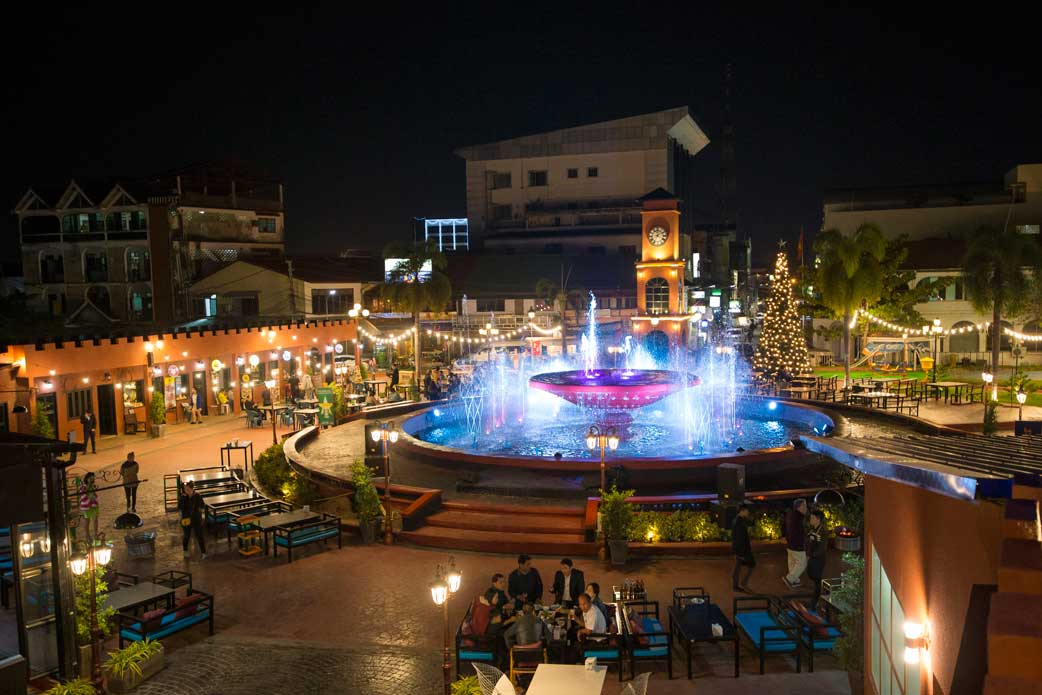ຖ້າຫາກຄົນຕ່າງປະເທດຖາມຄົນໃນນະຄອນຫຼວງວຽງຈັນວ່າເສັ້ນທາງເສດຖາທິລາດແມ່ນເສັ້ນໃດ ບາງຄົນກໍຈະຍັງງົງໆຢູ່, ແຕ່ຖ້າຫາກຖາມເຖິງສວນນໍ້າພຸ ທຸກຄົນກໍຈະຮ້ອງ ໂອ! ໃນທັນທີ.
ສວນນໍ້າພຸແຫ່ງນີ້ຕັ້ງຢູ່ຈຸດໃຈກາງຂອງເມືອງ, ໃຈກາງຂອງເຂດເສດຖະກິດທີ່ຟົດຟື້ນ ແລະ ມີນັກທ່ອງທ່ຽວຕ່າງຊາດແວະວຽນມາບໍ່ຂາດສາຍ.
 ໃນສະໄໝທີ່ສວນນໍ້າພຸຫາກໍສ້າງ ເຮົາສາມາດນັບໄດ້ເລີຍວ່ານໍ້າພຸໃນນະຄອນຫຼວງວຽງຈັນມີຈັກແຫ່ງ ມັນໄດ້ສ້າງຄວາມແປກໃໝ່ ແລະ ຕື່ນຕາຕື່ນໃຈໃຫ້ແກ່ເຮົາຫລາຍ. ຜູ້ຄົນມັກທີ່ຈະໄປຊຸມນຸມ ພົບປະກັັນ ແລະ ເຮັດກິດຈະກຳຢູ່ສວນນໍ້າພຸໃນຍາມເຊົ້າ-ແລງ ເຊັ່ນ ອອກກຳລັງກາຍ, ຍ່າງຫຼິ້ນ ເປັນຕົ້ນ. ອານຸຊາ ໂພທິສານ, ເຊິ່ງເຮົາກຳລັງສົນທະນາກັບເພິ່ນຕອນນີ້, ເລົ່າໃຫ້ຟັງວ່າ ເພິ່ນກໍເຄີຍມາເຕະບານຢູ່ເດີ່ນຂ້າງໆສວນນໍ້າພຸ ແລະ ມາຍ່າງຫລີ້ນຢູ່ບ່ອນນີ້ຄືກັນ.
ໃນສະໄໝທີ່ສວນນໍ້າພຸຫາກໍສ້າງ ເຮົາສາມາດນັບໄດ້ເລີຍວ່ານໍ້າພຸໃນນະຄອນຫຼວງວຽງຈັນມີຈັກແຫ່ງ ມັນໄດ້ສ້າງຄວາມແປກໃໝ່ ແລະ ຕື່ນຕາຕື່ນໃຈໃຫ້ແກ່ເຮົາຫລາຍ. ຜູ້ຄົນມັກທີ່ຈະໄປຊຸມນຸມ ພົບປະກັັນ ແລະ ເຮັດກິດຈະກຳຢູ່ສວນນໍ້າພຸໃນຍາມເຊົ້າ-ແລງ ເຊັ່ນ ອອກກຳລັງກາຍ, ຍ່າງຫຼິ້ນ ເປັນຕົ້ນ. ອານຸຊາ ໂພທິສານ, ເຊິ່ງເຮົາກຳລັງສົນທະນາກັບເພິ່ນຕອນນີ້, ເລົ່າໃຫ້ຟັງວ່າ ເພິ່ນກໍເຄີຍມາເຕະບານຢູ່ເດີ່ນຂ້າງໆສວນນໍ້າພຸ ແລະ ມາຍ່າງຫລີ້ນຢູ່ບ່ອນນີ້ຄືກັນ.
ແຕ່ເມື່ອເວລາຜ່ານໄປ, ຄວາມຕື່ນຕາຕື່ນໃຈກັບສິ່ງໃໝ່ກໍເລືອນຫາຍ ພ້ອມໆກັນກັບຄວາມຊຸດໂຊມລົງຂອງນໍ້າພຸ. ແລະ ໃນຊຸມປີ 2000, ນໍ້າພຸກາຍເປັນອີກບ່ອນໜຶ່ງທີ່ຜິດກັບເມື່ອຕອນສ້າງຕັ້ງ, ມັນໄດ້ກາຍເປັນບ່ອນຊຸມນຸມຂອງໄວລຸ້ນ ແລະ ເປັນມຸມມືດຂອງນະຄອນຫຼວງວຽງຈັນ. ຕໍ່ຈາກນັ້ນໃນປີ 2006, ສວນນໍ້າພຸກໍໄດ້ຖືກປິດລົງ ເພື່ອກັນບໍ່ໃຫ້ໄວລຸ້ນມາຊຸມນຸມກັນຢູ່ບ່ອນນີ້, ກາຍເປັນທີ່ບ່ອນທີ່ຮູ້ຈັກກັນດີວ່າເປັນສະຖານທີ່ທີ່ຊື່ສຽງດ້ານບວກບໍ່ມີ.
“ນັ້ນເປັນຕອນທີ່ລັດຖະບານເອີ້ນໃຫ້ນັກພັດທະນາທັງຫຼາຍເຂົ້າມາ ແລະ ປ່ຽນສວນນໍ້າພຸເເຫ່ງນີ້ໃຫ້ເປັນສະຖານທີ່ສາທາລະນະທີ່ດີຂຶ້ນ, ບ່ອນທີ່ສົດໃສ ແລະ ຕ້ອນຮັບຜູ້ຄົນ” ກ່າວໂດຍ ອານຸຊາ.
 ຫຼັງຈາກນັ້ນ, ບາຣ໌ຕ່າງໆກໍໄດ້ເກິດຂື້ນ, ມີການເປີດແຜງຂາຍເຄື່ອງ ແລະ ເວທີດົນຕີກໍມາ. ມັນບໍ່ໄດ້ມີຫຍັງໃໝ່ເປັນພິເສດ, ແຕ່ມັນໄດ້ເຮັດໃຫ້ສວນນີ້ມີຊີວິດຊີວາຂຶ້ນ ແລະ ພະຍາຍາມລົບລ້າງປະຫວັດບໍ່ດີອອກໄປ. ແຕ່ວ່າ ຄວາມສໍາຄັນຂອງສວນນໍ້າພຸທີ່ເຄີຍເປັນສັນຍາລັກຂອງເຂດນີ້ໄດ້ຫຼຸດລົງ.
ຫຼັງຈາກນັ້ນ, ບາຣ໌ຕ່າງໆກໍໄດ້ເກິດຂື້ນ, ມີການເປີດແຜງຂາຍເຄື່ອງ ແລະ ເວທີດົນຕີກໍມາ. ມັນບໍ່ໄດ້ມີຫຍັງໃໝ່ເປັນພິເສດ, ແຕ່ມັນໄດ້ເຮັດໃຫ້ສວນນີ້ມີຊີວິດຊີວາຂຶ້ນ ແລະ ພະຍາຍາມລົບລ້າງປະຫວັດບໍ່ດີອອກໄປ. ແຕ່ວ່າ ຄວາມສໍາຄັນຂອງສວນນໍ້າພຸທີ່ເຄີຍເປັນສັນຍາລັກຂອງເຂດນີ້ໄດ້ຫຼຸດລົງ.
ສະນັ້ນ, ເຈົ້າຂອງສຳປະທານຂອງນໍ້າພຸຈຶ່ງໄດ້ເອີ້ນ ອານຸຊາ ເຊິ່ງເປັນຜູ້ສ້າງ Walking Street, M Park ແລະ Si Khai Park, ມາລົມເພື່ອສ້າງຊີວິດໃຫ້ສວນນໍ້າພຸອີກຄັ້ງ. ອານຸຊາມີເວລາສອງເດືອນໃນການປ່ຽນໂສມສະຖານທີ່ແຫ່ງນີ້, ເພິ່ນໄດ້ເຮັດການສຳຫຼວດເຖິງປະຫວັດຂອງເຂດນີ້ ແລະ ປ່ຽນຈຸດປະສົງຂອງມັນໃຫ້ມີຄວາມທັນສະໄໝຂຶ້ນ. ແມ້ແຕ່ຄົນໃນເມືອງເອງ, ການປ່ຽນແປງນີ້ຄືຜ່ານໄປຢ່າງໄວວາ, ໂຄງສ້າງບາງຢ່າງໄດ້ຖືກມ້າງລົງ, ຫໍໂມງໄດ້ຖືກຕັ້ງຂື້ນ, ສະຖານທີ່ຖືກທໍາຄວາມສະອາດ ແລະ ທາສີໃໝ່ ເພື່ອໃຫ້ທັນກັບຊ່ວງທີ່ນັກທ່ອງທ່ຽວມາຫຼາຍໃນເດືອນທັນວາ.
ສວນນໍ້າພຸຖືກປະດັບປະດາໃໝ່ດ້ວຍໄຟແສງສີ, ໂຕະ ແລະ ຕັ່ງໄດ້ຖືກວາງໄວ້ ໃຫ້ຄວາມຮູ້ສຶກສະບາຍໆຄ້າຍໆກັນກັບຖະໜົນຄົນຍ່າງ. ແຕ່ວ່າ ອານຸຊາໄດ້ຕັ້ງເປົ້າວ່າເພິ່ນຕ້ອງການທີ່ຈະຄົງປະຫວັດຂອງສະຖານທີ່ແຫ່ງນີ້ໄວ້.
“ພວກເຮົາຢາກໃຫ້ສວນນີ້ຍັງເປັນແບບໂຄໂລນຽວ, ເພາະວ່າບັນດາຕຶກອ້ອມຂ້າງຂອງສວນລ້ວນແລ້ວແຕ່ເປັນຕົວຢ່າງແຫ່ງສະຖາປັດຕະຍະກຳແບບຝຣັ່ງ” ກ່າວໂດຍ ອານຸຊາ.
“ເປັນສະຖານທີ່ແຫ່ງດຽວໃນວຽງຈັນທີ່ມີທຸກຢ່າງໃນ, ຂ້ອຍບໍ່ຕ້ອງການປັບປ່ຽນ ພຽງແຕ່ເພີ່ມຄວາມທັນສະໄໝເຂົ້າໄປ ເພື່ອເປັນທີ່ດຶງດູດຂອງນັກທ່ອງທ່ຽວໃຫ້ຫຼາຍຂຶ້ນ”
ແຕ່ເໜືອກວ່າຄວາມທັນສະໄໝທີ່ເພິ່ນໄດ້ເພີ່ມເຂົ້າມານັ້ນ, ເພິ່ນຢາກໃຫ້ບ່ອນນີ້ກາຍເປັນຈຸດຕໍ່ດ້ານວັດທະນະທຳ ສຳລັບສິນລະປິນລາວທັງຫຼາຍທີ່ບໍ່ມີບ່ອນສ້າງສັນຜົນງານ.
“ຂ້ອຍມີສອງແນວຄິດ – ອັນທຳອິດແມ່ນຢາກໃຫ້ມີຮ້ານອາຫານ ກັບ ສວນບາຣ໌ – ແລະ ອັນທີ 2 ແມ່ນຢາກໃຫ້ເປັນພື້ນທີ່ວັດທະນະທຳ” ເພິ່ນໄດ້ກ່າວໄວ້.
“ສ່ວນໜຶ່ງຂອງເຂດນີ້ຈະແມ່ນເພື່ອສິນລະປິນທັງໝົດໃນລາວ – ຊ່າງຖ່າຍພາບ, ນັກເຕັ້ນ, ນັກດົນຕີ – ໃຫ້ເຂົາເຈົ້ານໍາໃຊ້ພື້ນທີ່ຟຣີ ເພື່ອສ້າງ ແລະ ສະແດງຜົນງານຂອງເຂົາເຈົ້າ. ສິນລະປິນສ່ວນຫຼາຍບໍ່ມີພື້ນທີ່ໃນການຊ້ອມ ຫຼື ສະແດງຜົນງານຂອງເຂົາເຈົ້າ, ຫຼືເຖິງມີກະບໍ່ຟຣີ”. ໂຄງການນີ້ກໍຍັງເພື່ອຕື່ມເຕັມຝັນສ່ວນຕົວຂອງອານຸຊາ, ເຊິ່ງເປັນໜຶ່ງໃນຜູ້ກໍ່ຕັ້ງ ກູ່ມເຕັ້ນລາວບັ້ງໄຟ.
“ຂ້ອຍກໍເປັນສິນລະປິນຄືກັນ, ເປັນຄົນອອກແແບບທ່າເຕັ້ນ, ແລະ ຂ້ອຍຮູ້ສະຖານນະການດີ. ພວກເຮົາມີສິນລະປິນຫຼາຍໃນເມືອງ, ແຕ່ພວກເຂົາບໍ່ມີສະຖານທີ່ທີ່ເຂົ້າເຖິງເພື່ອພົບກັນ ແລະ ເຮັດໃຫ້ເກີດຄວາມຄິດສ້າງສັນໄດ້”



 English
English
